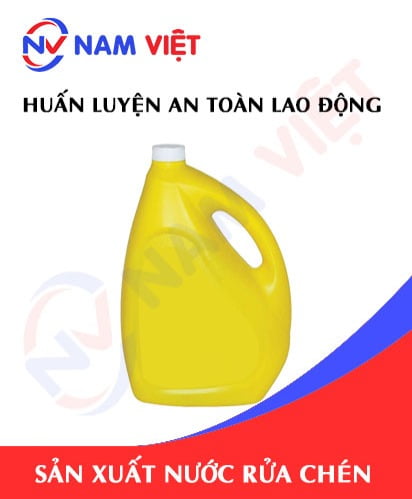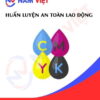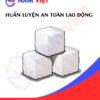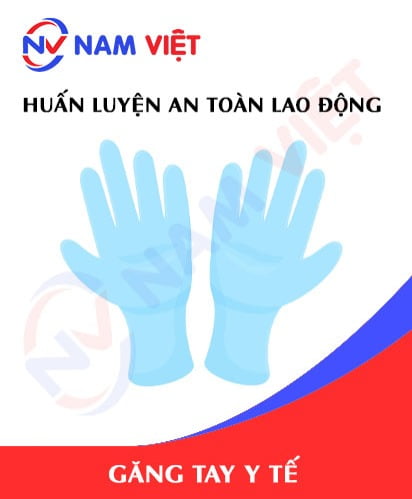Occupational Safety Training for Dish Soap Production
99,000 ₫
Note: The above price is calculated per person; prices may vary depending on the number of trainees participating in the course and market fluctuations. For more accurate pricing support, please refer to the pricing table or contact our consultants directly.
Occupational safety is an important issue in dish soap production factories and needs to be addressed promptly to ensure the health and safety of workers and enhance the reputation of businesses. The Occupational Safety Training course is an effective solution to raise awareness about preventing workplace accidents for workers involved in dish soap production.
Table of Contents
Toggle1. Overview of dish soap
a. What is dish soap?
- Dish soap is a liquid solution used for washing dishes, kitchen utensils, and other surfaces related to food preparation. It is often produced and sold in liquid or powder form and can be used to remove grease, oil, and other dirt from surfaces. Dish soap usually contains surfactants, which act as surface cleaners, as well as cleaning and foaming agents.
- Other ingredients may also be added to increase cleaning and deodorizing capabilities, and sometimes antibacterial agents are also added to prevent the growth of bacteria on surfaces. Dish soap is a very popular and essential product for maintaining family hygiene and health.
- The dish soap manufacturing industry in Vietnam has been developing strongly in recent years. According to a report by the Market Management Department, the production output of dish soap in Vietnam has increased significantly over the past years, reaching about 200,000 – 250,000 tons/year. Businesses in the industry are focusing on product research and development to meet consumer needs, while also trying to improve product quality and compete in the market.
- However, controlling product quality and ensuring food safety and hygiene are still issues that need to be addressed and resolved in the dish soap manufacturing industry in Vietnam. State management agencies need to continue to strengthen supervision, inspection, and handling of violations to ensure the health and safety of consumers.

b. Types of machinery for dish soap production
The types of machinery commonly used in the dish soap production process include:
- Mixing machine: Used to mix ingredients and chemicals to create the dish soap solution. The mixing machine can be controlled manually or automatically.
- Packaging machine: Used to package the product after it has been produced. The packaging machine can be used to package in various forms such as bottles, boxes, or pouches.
- Filling machine: Used to extract and pour the product into the packaging. The filling machine can be used to extract and pour the product into bottles or pouches.
- Date printing machine: Used to print the production date and expiration date on the product packaging.
- Sealing machine: Used to seal the product packaging.
- Carton sealing machine: Used to seal the carton boxes containing the products before delivering them to the shipping units.
These types of machinery can be integrated and automated in dish soap production lines to optimize production efficiency and reduce the working time of workers.

c. Typical dish soap manufacturing companies
In Vietnam, there are many typical dish soap manufacturing companies such as:
- Unilever Vietnam: One of the largest multinational companies in Vietnam, producing many famous products, including Sunlight dish soap.
- P&G Vietnam: A leading global manufacturing company with many famous products such as Tide dish soap.
- SC Johnson Vietnam: A multinational company producing household products such as Baygon, Glade, Pledge, Raid, and Windex, including Mr. Muscle dish soap.
- Colgate-Palmolive Vietnam: A company specializing in producing oral care, hair care products, and Palmolive dish soap.
- Viet Han Trading Joint Stock Company: A dish soap manufacturing business in Vietnam, producing and distributing many famous products such as Lifebuoy, Lix, VIM, and Pureit.
The above-mentioned companies have invested heavily in technology and production processes, ensuring quality and safety for consumers.
d. Specific jobs in a dish soap manufacturing factory
Group 1
- Executive director, deputy executive director, department head in a dish soap manufacturing factory.
Group 2
- Safety officer: manages factory safety, designs safety procedures, supervises, and urges employees to comply with safe work procedures.
Group 3
- Raw material purchasing: This includes purchasing the necessary raw materials to produce dish soap such as caustic soda, fragrances, essential oils, solvents, water…
- Raw material inspection: Ensuring raw materials meet quality and safety requirements for use.
- Mixing: This is the most important stage in dish soap production; it is necessary to ensure the correct mixing ratio for the product to meet quality standards, provide chemical components, and ensure the health and safety of consumers.
- Packaging: After mixing, the product is packaged in containers such as bottles, pouches, cartons, or spray bottles.
- Quality control: The product is checked for quality using physical, chemical, and microbiological testing methods.
- Equipment maintenance and repair: Ensuring machinery operates well and meets production requirements.
- Factory sanitation: Ensuring the factory is always clean, safe, and complies with sanitation and work safety procedures.
- Production management: Directing factory operations, controlling product quality, and ensuring continuous and efficient production.
Group 4
- Office jobs, serving, sales, marketing.
- Production management, quality management, human resource management, material management, financial accounting management.
- Research and development of new products, design of product packaging.
- Production planning: Adjusting the production process, planning output, raw materials, technology, and production time.

2. Overview of the work safety training course for dish soap production
Within the scope of this article, we will focus on issues related to group 3, because group 3 is the group that directly participates in the production process and is exposed to the highest risk of workplace accidents. Refer to other groups here
a. What is group 3 work safety training?
- Work safety training for group 3 consists of classes that equip employees with the knowledge to prevent workplace accidents.
- The work safety training course will help employees recognize and prevent hazards, limiting the risks of workplace accidents while they work.
REGISTER FOR WORK SAFETY TRAINING SERVICES
b. Training duration
First-time safety training duration
- The total training duration is at least 24 hours, including the examination time.
- 8 hours of theoretical study on the policy and legal system regarding occupational safety and health.
- 8 hours of theoretical study on basic knowledge of occupational safety and health.
- 4 hours of theoretical study on specialized training content.
- 2 hours of practical training on specialized training content.
- 2 hours of theoretical examination at the end of the training course.
The safety training center will distribute the time into several training sessions depending on the time arrangement for employees. However, there are usually 6 training sessions, and the course will last 3 days, provided that the manufacturing company can arrange continuous study time.
Periodic safety training duration
- Before the work safety card expires, if employees want it renewed, they must undergo a periodic work safety training course, with the periodic safety training duration being at least 50% of the first-time safety training duration.
Explanation: the total periodic work safety training time is at least 12 hours, including the examination time. After completing the periodic training course and passing the examination, the employee will have their work safety card renewed.
c. Content of the training course
| No. | TRAINING CONTENT | TRAINING DURATION (HOURS) | |||
| Total | Of which | ||||
| Theory | Practice | Exam | |||
| I | Policy and legal system regarding occupational safety and health | 8 | 8 | 0 | 0 |
| 1 | Overview of the legal documents system on occupational safety and health. | 6 | 6 | ||
| 2 | System of technical standards and regulations on occupational safety and health. | 1 | 1 | ||
| 3 | Specific regulations of state management agencies on occupational safety and health when building new, expanding, or renovating facilities for production, use, preservation, storage, and inspection of machinery, equipment, materials, and substances with strict requirements on occupational safety and health. | 1 | 1 | ||
| II | Basic knowledge of occupational safety and health | 8 | 8 | 0 | 0 |
| 1 | Basic knowledge of hazardous and harmful factors in the workplace. | 4 | 4 | ||
| 2 | Methods for improving working conditions. | 1 | 1 | ||
| 3 | Safety culture in production and business. | 1 | 1 | ||
| 4 | Rights and obligations of employers and employees; policies and regimes on occupational safety and health for employees; functions and duties of the occupational safety and health network. | 1 | 1 | ||
| 5 | Occupational safety and health regulations, safety signs, safety instructions, and the use of safety equipment, personal protective equipment; first aid skills for workplace accidents, and prevention of occupational diseases. | 1 | 1 | ||
| III | Specialized training content | 6 | 4 | 2 | 0 |
| General knowledge about types of machinery, equipment, and substances that generate hazardous and harmful factors; analysis, assessment, and management of risks related to occupational safety and health, safe working procedures with machinery, equipment, and substances that have strict requirements on occupational safety and health. | 6 | 4 | 2 | ||
| IV | Safety training examination at the end of the training course | 2 | 2 | 0 | 0 |
| Total | 24 | 22 | 2 | ||
See more training content for 6 groups
d. Work safety card
After completing the work safety training course and passing the exam, the employee will be granted a work safety card (in practice, also called the group 3 work safety certificate).
The group 3 safety card will clearly show information such as: full name, date of birth, specific job, and working environment. It also includes the training duration, a red seal, and a signature confirming the completion of the training course.
According to the regulations for issuing safety cards as specified in clause 2 of Article 24 of Decree 44/2016/ND-CP, there are two cases:
- In the case where the employer and the employee have a labor contract, the employer must sign, seal, and laminate the safety card for the trained person in group 3 after they undergo the training course from a work safety training unit and pass the exam.
- In the case of a freelancer or seasonal worker who does not have a labor contract, the training unit must sign, seal, and laminate the safety card for the employee after they undergo the training course from a work safety training unit and pass the exam.

3. Identifying hazards when producing dish soap
Dish soap production can pose many potential risks to work safety, hygiene, and the environment. Some hazards to be aware of include:
- Dish soap contains chemicals such as caustic soda, acids, essential oils, and fragrances, which can harm the health of workers if not used correctly. Additionally, these chemicals can also have a negative impact on the environment if not disposed of properly.
- Operating dish soap production machinery can be dangerous for workers if not done correctly. Machinery must be maintained periodically to ensure stable and safe operation.
- A dish soap factory uses a lot of electrical equipment, which can be dangerous for workers if not used correctly.
- Dish soap is a favorable environment for the growth of bacteria and mold. Therefore, maintaining good hygiene in a dish soap factory is very important to ensure food safety and consumer health.
- Dish soap production generates a lot of waste such as wastewater and packaging, which, if not disposed of properly, will cause environmental pollution and affect human health.
4. Common workplace accidents when producing dish soap
Common workplace accidents when producing dish soap can include:
- Chemical-related accidents: When working with chemicals during production, employees can have direct contact with hazardous substances, causing skin and eye irritation or respiratory issues.
- Machinery-related accidents: Employees can be injured when using production equipment, including pressing machines, bottling machines, mixing machines, and other machinery.
- Physical impact accidents: Employees can be injured by heavy materials or tools falling or colliding with each other.
- Accidents due to improper use of personal protective equipment: Employees need to use personal protective equipment such as safety glasses, masks, gloves, cool vests, and helmets to protect their health, but if not used correctly, it can lead to accidents like poisoning or injuries.
- Physical strain accidents: Employees can experience health problems from working in high-pressure or low-temperature environments for long periods. Lifting heavy objects can also cause injuries and harm to employees’ health.
5. Safety measures for dish soap production
To ensure work safety and consumer safety, safety measures must be implemented when producing dish soap, including:
- Employees in the dish soap factory need to use full protective equipment such as helmets, safety glasses, masks, gloves, protective clothing, and safety shoes. This helps protect employees from physical, chemical, thermal, and other hazards and injuries.
- Dish soap manufacturing companies need to organize work safety training for employees on work safety and safe working procedures. Employees need to be trained to use protective equipment correctly, understand the effects of chemicals, and handle emergency situations.
- Dish soap production processes need to be closely monitored to ensure the safety of employees and the quality of the product. Employees must adhere to the production process and check equipment, machinery, and chemicals before use.
- Dish soap production machinery and equipment need to be checked periodically to ensure they are working properly and are safe for employees. Damaged machinery and equipment must be repaired or replaced immediately.
- Waste from the production process needs to be managed safely and properly to ensure no environmental pollution. Dish soap manufacturing companies need to have a waste management plan and comply with legal regulations on waste management.
- Dish soap manufacturing companies need to conduct product quality checks to ensure the product meets quality and safety standards for consumers.
- Periodically organize work environment monitoring in factories and enterprises, collecting and analyzing harmful factors to employees, thereby adjusting to reduce the level of harm to prevent occupational diseases for them.

6. Benefits of work safety training for dish soap production
An Toan Nam Viet provides businesses with excellent benefits after completing the work safety training courses in accordance with Decree 44/2016/ND – CP on occupational safety and health.
- Employees can recognize the potential risks of workplace accidents and take preventive measures to avoid them.
- Your business can establish risk prevention measures in the production, operation, and maintenance process.
- Reduce costs when safety risks occur in the workplace.
- Uninterrupted production will help increase labor productivity and product quality.
- Comply with work safety laws, avoiding legal risks.
- Create prestige and professionalism in all aspects, thereby enhancing your business’s brand.
Nam Viet’s training courses are a solution to prevent and combat external factors that can lead to injury or, more seriously, death for individuals.
REGISTER FOR WORK SAFETY TRAINING SERVICES
7. Customer feedback after completing the work safety training course for dish soap production
An Toan Nam Viet has many years of experience in accompanying many businesses in Vietnam in general and in the southern provinces in particular. And that responsibility is something very valuable to Nam Viet, which is why Nam Viet’s work safety training is increasingly professional. And the motivation for An Toan Nam Viet to grow strong to this day comes from the positive feedback and suggestions from businesses. Below are the feedback from our partners that we have served.
Bac Nam E&C Construction Investment Joint Stock Company
“The first time I used An Toan Nam Viet’s service, I was very surprised by the enthusiastic 24/7 support from the consulting team. The class organization was very quick and convenient for our company, thank you very much for Nam Viet’s service!”
Hoa Dat Construction and Trading Joint Stock Company
“Nam Viet’s service has helped us a lot in simplifying work safety and the process of completing safety records to serve our work. The consulting team is enthusiastic and timely in answering our questions. 5 stars for Nam Viet”
See more customer interviews after using An Toan Nam Viet’s services
8. An Toan Nam Viet’s Work Safety Training Capacity
An Toan Nam Viet is a reputable and high-quality work safety training center in Vietnam today. With work safety training sessions held continuously at production workshops, factories, or construction sites across the country (in all 63 provinces and cities in Vietnam).
REGISTER FOR WORK SAFETY TRAINING SERVICES
Work safety training license
- An Toan Nam Viet has been inspected and granted a certificate of eligibility to operate in occupational safety and health training by the Department of Work Safety under the Ministry of Labor, Invalids and Social Affairs. This further strengthens our capacity to operate in work safety training.

Tài liệu và bài giảng
- Before the work safety training materials are included in the work safety training courses, they are reviewed and approved to ensure that the lectures are accurate in terms of knowledge and effective when applied.
- The teaching methods of the lecturers are synchronized according to the teaching standards of An Toan Nam Viet, which are methods that experts in occupational safety and health training have researched and refined during the teaching process to bring the highest knowledge retention for students.
Cơ sở vật chất
- Controlling factors in the classroom that affect the training process will increase teaching efficiency and knowledge retention for students.
- Our facilities supporting the training course always have spacious classrooms that meet standards for area, lighting, training equipment, etc.
9. Reputable and high-quality nationwide safety training center
At An Toan Nam Viet, we always prioritize our professional dedication to work safety training. For us, imparting the knowledge of self-protection to workers so they have a safe foundation on their career path is a contribution to building the country.
To ensure effective training, we prepare every little thing carefully and meticulously. From preparing teaching tools, equipment, textbooks, and materials to sound and lighting.
Our work safety training lecturers are experts with many years of experience in the field. They even have research projects on identifying hazards in all occupations and how to prevent them.
The lecturers’ lessons are distilled from practical experience and are conveyed in the most vivid and easy-to-understand way for workers. These factors help workers feel comfortable during their study time and better absorb our taught knowledge. Of course, the knowledge conveyed always strictly adheres to Decree 44/2016/ND-CP.
From there, they grasp many measures to prevent hazards and how to protect themselves. At the same time, they also apply it in the most appropriate way in their actual work.
Our safety training center is proud to be a reputable and professional provider of work safety training services with the following advantages:
- Competitive training costs while still ensuring the quality of the training.
- Flexible training schedule to suit the production situation of the company.
- The procedure for a work safety training certificate is quick and in accordance with the law.
- The training lecturers are people with many years of experience in the profession.
- The classroom environment is controlled to increase teaching efficiency and the effectiveness of knowledge absorption by students.
- The lectures are compiled to be suitable for work safety practices at businesses.
- An Toan Nam Viet works with dedication and professionalism to support customers accurately and quickly.

10. Refer to more work safety training materials for dish soap production
- Work safety materials for dish soap production
- Work safety training materials
- Set of work safety training test questions
- Work safety multiple-choice test for dish soap production
- Work safety training lecture slides for dish soap production
1 review for Occupational Safety Training for Dish Soap Production
No comments yet















namchinh.haiphong341
Dịch vụ tốt!!!